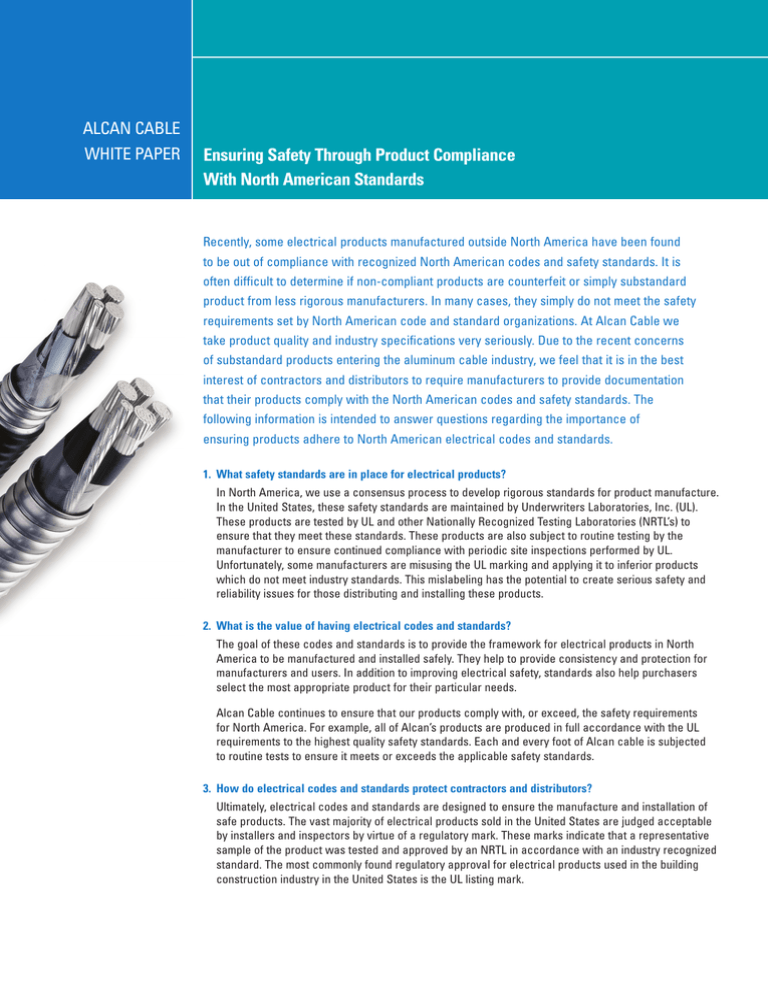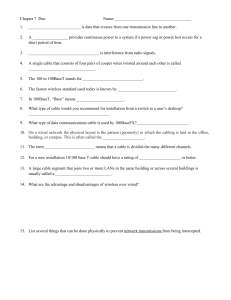Ensuring Safety Through Product Compliance With North
advertisement

ALCAN CABLE WHITE PAPER Ensuring Safety Through Product Compliance With North American Standards Recently, some electrical products manufactured outside North America have been found to be out of compliance with recognized North American codes and safety standards. It is often difficult to determine if non-compliant products are counterfeit or simply substandard product from less rigorous manufacturers. In many cases, they simply do not meet the safety requirements set by North American code and standard organizations. At Alcan Cable we take product quality and industry specifications very seriously. Due to the recent concerns of substandard products entering the aluminum cable industry, we feel that it is in the best interest of contractors and distributors to require manufacturers to provide documentation that their products comply with the North American codes and safety standards. The following information is intended to answer questions regarding the importance of ensuring products adhere to North American electrical codes and standards. 1. What safety standards are in place for electrical products? In North America, we use a consensus process to develop rigorous standards for product manufacture. In the United States, these safety standards are maintained by Underwriters Laboratories, Inc. (UL). These products are tested by UL and other Nationally Recognized Testing Laboratories (NRTL’s) to ensure that they meet these standards. These products are also subject to routine testing by the manufacturer to ensure continued compliance with periodic site inspections performed by UL. Unfortunately, some manufacturers are misusing the UL marking and applying it to inferior products which do not meet industry standards. This mislabeling has the potential to create serious safety and reliability issues for those distributing and installing these products. 2. What is the value of having electrical codes and standards? The goal of these codes and standards is to provide the framework for electrical products in North America to be manufactured and installed safely. They help to provide consistency and protection for manufacturers and users. In addition to improving electrical safety, standards also help purchasers select the most appropriate product for their particular needs. Alcan Cable continues to ensure that our products comply with, or exceed, the safety requirements for North America. For example, all of Alcan’s products are produced in full accordance with the UL requirements to the highest quality safety standards. Each and every foot of Alcan cable is subjected to routine tests to ensure it meets or exceeds the applicable safety standards. 3. How do electrical codes and standards protect contractors and distributors? Ultimately, electrical codes and standards are designed to ensure the manufacture and installation of safe products. The vast majority of electrical products sold in the United States are judged acceptable by installers and inspectors by virtue of a regulatory mark. These marks indicate that a representative sample of the product was tested and approved by an NRTL in accordance with an industry recognized standard. The most commonly found regulatory approval for electrical products used in the building construction industry in the United States is the UL listing mark. Alcan Cable understands that the electrical contractor may be legally responsible for and consequently should be wary of any product that is not produced by an approved manufacturer, certified by a nationally recognized testing service and sold by a reputable wholesale electrical distributor. 5.Who is involved in developing electrical codes and product standards? It may not be evident to the general public the amount of effort that the electrical industry expends to make sure that products used in the industry comply with recognized industry codes and standards. In all cases, safety is the primary focus of the various organizations. Here is a partial list of some of the organizations working hard to make sure that products installed in North America comply with those provisions considered necessary for safety: AA - Aluminum Association ASTM - American Society for Testing and Materials IEEE - Institute of Electrical and Electronics Engineers - NESC - National Electrical Safety Code ICEA - Insulated Cable Engineers Association IEC - International Electrotechnical Commission NEMA - National Electrical Manufacturers Association - EFC - Electro Federation of Canada CANENA – Council for Harmonization of Electrotechnical Standardization of North America ANSI - American National Standards Institute RUS - Rural Utilities Service NFPA - National Fire Protection Association - NEC - National Electrical Code UL - Underwriters Laboratories CSA - Canadian Standards Association - CEC - Canadian Electrical Code - Product Standards ANCE - Association of Standardization and Certification IAEI - International Association of Electrical Inspectors Product standards are also developed through a consensus process designed to define prescriptive and performance product requirements needed to support code recognition and provide the framework for product certification as well as define provisions considered necessary for safety. 7. How are codes and standards enforced? Enforcement is everyone’s responsibility. Codes, standards and enforcement are all required in order to ensure manufacturing and installation of safe electrical products. Below is a graph that shows the relationship between codes, product standards and enforcement. Relationship Between the Codes. Product Standards and Enforcements. ?) w En Co Manufacturing and Installation of Safe Products fo r hat?) (W de • • • • • • • • • • • • • • Installation codes are developed through a consensus process designed to define the requirements for safe installation, provide recognition and ensure the use of safe products, as well as define provisions considered necessary for safety. so ? ) By purchasing and installing noncompliant products, contractors risk exposing themselves to liability for product failures and any resulting safety issues. In the event of long-term product reliability issues, there may be no recourse for building owners and contractors who have issues with electrical product quality or performance. 6. How does the code and standards development process work? Standa rd (H o 4. What are the consequences of using non-compliant products? ce m t ent (Is tha Ensuring safety for the entire industry is the ultimate goal of establishing and implementing code and product standards. Non-compliant electrical products, including those which misuse the UL mark, may have serious safety implications to the electrical industry. Contractors and distributors can help maintain safe products and installations by insisting that products manufactured in various parts of the world comply with North American codes and standards. As part of the cable selection process, contractors should require proof from the manufacturer that their product is UL listed before making the cable purchase. These organizations have safety in mind when developing codes and standards for North America. Alcan Cable Three Ravinia Drive, Suite 1600, Atlanta, Georgia 30346 | Tel (770) 392-2307 Toll Free (800) 347-0571 s. 2307



